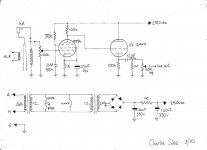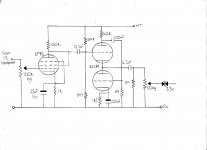Hi all,
So im putting the 1KW project to one side, and am going for something a little smaller.
Im planning on building a mic preamp, I think possibly a stereo pentode preamp, and also a stereo triode preamp.
Now ive had a look at the other designs on this forum, like the Cascode mic preamp on this thread...
http://www.diyaudio.com/forums/tubes-valves/156658-microphone-preamp.html
.. it has some interesting points on it, I plan on stealing the pad and invert switch idea, but it seems very large.
I have designed this preamp to be as simple as possible, trying to minimize how many components the signal will go through to keep it as clean as possible.
Im really asking you guys if you can comment on the circuit, any obvious faults or changes I should fix. In the diagram there are 2 level pots, I think when building it ill only use one at the input.
I was going to attach a phantom power circuit I made, but its very similar to the cascode design on the other thread.
I think thats it for now, other than this is the transformer I plan on using.
High perforamance microphone and line input transformers
Looking forward to your comments.
Cheers
Charlie
So im putting the 1KW project to one side, and am going for something a little smaller.
Im planning on building a mic preamp, I think possibly a stereo pentode preamp, and also a stereo triode preamp.
Now ive had a look at the other designs on this forum, like the Cascode mic preamp on this thread...
http://www.diyaudio.com/forums/tubes-valves/156658-microphone-preamp.html
.. it has some interesting points on it, I plan on stealing the pad and invert switch idea, but it seems very large.
I have designed this preamp to be as simple as possible, trying to minimize how many components the signal will go through to keep it as clean as possible.
Im really asking you guys if you can comment on the circuit, any obvious faults or changes I should fix. In the diagram there are 2 level pots, I think when building it ill only use one at the input.
I was going to attach a phantom power circuit I made, but its very similar to the cascode design on the other thread.
I think thats it for now, other than this is the transformer I plan on using.
High perforamance microphone and line input transformers
Looking forward to your comments.
Cheers
Charlie
Attachments
OK, Brian Sowter has very kindly suggested that I should use this for the input for more gain and less noise..
High perforamance microphone and line input transformers
And this if I want a balanced floating output..
Isolating and Balancing Transformers
very helpful, thanks Brian
High perforamance microphone and line input transformers
And this if I want a balanced floating output..
Isolating and Balancing Transformers
very helpful, thanks Brian
There is no decoupling on EF86 screen grid, which will make pentode partition noise even worse. The ECC83 does not make a very good CF, as the gm is too low - try ECC81? Keep DC away from pots, and don't trust them as DC paths, so you need a separate grid leak resistor and DC block capacitor at the EF86 grid. A diode or neon from grid to cathode on the CF would prevent any arcing during warm-up.
Your diagram seems to confuse g2 and g3. Why is there a capacitor from g1 to ground? Why use a pentode at all? A triode would be quieter.
Your diagram seems to confuse g2 and g3. Why is there a capacitor from g1 to ground? Why use a pentode at all? A triode would be quieter.
Thanks for those pointers, ill change my circuit around.
The idea is to have the option for pentode and triode preamplification.
I have a 12AU7 spare, would this act as a better cathode follower?
thanks
The idea is to have the option for pentode and triode preamplification.
I have a 12AU7 spare, would this act as a better cathode follower?
thanks
Here is an updated design,
Its essentially the white cathode follower from Morgan Jones, it just seemed like the next logical design step. And ive altered the EF86 to triode mode to reduce noise.
All your comments are really helpful guys
thanks
Charlie
Its essentially the white cathode follower from Morgan Jones, it just seemed like the next logical design step. And ive altered the EF86 to triode mode to reduce noise.
All your comments are really helpful guys
thanks
Charlie
Attachments
Since you seem to be planning to run your EF86 a bit hotter than suggested by the datasheet perhaps a 100R between anode and G2 wouldn't hurt ? This keeps screen at slightly lower potential than the anode, thereby reducing screen current (and dissipation).
thanks for that, the real reason for using the EF86 is that I have a couple spare. But if theres a more suitable valve id certainly consider buying one.
thanks
thanks
I think EF86 is a fine tube for microphone amplifier. If I were you I'd copy one of existing schematics (there are quite some floating around, use Google to look them up). This will give you decent results and something you can learn from.
there are lots of good designs that im taking ideas from, but im really trying to make it as simple as I can... and most of these designs are old and use too many stages
And ive altered the EF86 to triode mode to reduce noise.
Are you sure you'll still have enough gain? What amp are you using it with?
I think the white cathode follower will produce the gain I need, but the 50K pot was just an output value for my design, if you can offer a better value that would be great.
And Leadbelly, its for a microphone preamp, its not matched for an amp but for general mixing desks. hense the 2 zener diodes on the output to stop clipping...
.... maybe someone can tell me if these diodes are a good idea or not... it seemed sensible to me, but i havnt seen it in any other schematics
thanks for your comments..... still learning
And Leadbelly, its for a microphone preamp, its not matched for an amp but for general mixing desks. hense the 2 zener diodes on the output to stop clipping...
.... maybe someone can tell me if these diodes are a good idea or not... it seemed sensible to me, but i havnt seen it in any other schematics
thanks for your comments..... still learning
Hi Charlie,
Looks like you now have the EF86 working as a triode. This will have a lot less gain than as a pentode. Overall with the 1:7 mic tranfromer and the EF86 as a pentode you will not have enough gain for many applications.
Also, this circuit is inherently noisy due to the 100K log pot at the EF86 grid. You might want to re-think the basic topology before detailing a circuit.
Cheers
Ian
Looks like you now have the EF86 working as a triode. This will have a lot less gain than as a pentode. Overall with the 1:7 mic tranfromer and the EF86 as a pentode you will not have enough gain for many applications.
Also, this circuit is inherently noisy due to the 100K log pot at the EF86 grid. You might want to re-think the basic topology before detailing a circuit.
Cheers
Ian
Hi Ian,
Thanks for your input. You are right, im re-thinking many things with the design of my preamp. In fact, im about to undertake a M.Phil in the research and design of a mic preamp.
So look forward to picking your brains with my ideas over the next few years.
Charlie
Thanks for your input. You are right, im re-thinking many things with the design of my preamp. In fact, im about to undertake a M.Phil in the research and design of a mic preamp.
So look forward to picking your brains with my ideas over the next few years.
Charlie
Hi Charlie,
Yes, I saw your earlier posts about the M.Phil - nice subject!
I am happy to discuss mic pres with you anytime. See my web site and I am sure you will understand why....
Custom Tube Consoles
Cheers
Ian
Yes, I saw your earlier posts about the M.Phil - nice subject!
I am happy to discuss mic pres with you anytime. See my web site and I am sure you will understand why....
Custom Tube Consoles
Cheers
Ian
Hi Ian,
Great Website! Lots of the same ideals as me, which is great to see. I look forward to picking your brain about the subject.
Had a final meeting today about the proposal for my M.Phil, and its really exciting.
Lots of ideas
Cheers
Charlie
Great Website! Lots of the same ideals as me, which is great to see. I look forward to picking your brain about the subject.
Had a final meeting today about the proposal for my M.Phil, and its really exciting.
Lots of ideas
Cheers
Charlie
Ian
At the moment im still behind on reading material.
I have both Morgan Jones
Allen Wright Preamp Cookbook
High-end Vlave amplifiers 2
Analogue Circutis (world class designs) R. Pease
I also have soft copies of Radio Designers Handbook etc.
Can you recommend any reading material for me? Something a bit more inclined towards microphone preamps
Cheers
Charlie
At the moment im still behind on reading material.
I have both Morgan Jones
Allen Wright Preamp Cookbook
High-end Vlave amplifiers 2
Analogue Circutis (world class designs) R. Pease
I also have soft copies of Radio Designers Handbook etc.
Can you recommend any reading material for me? Something a bit more inclined towards microphone preamps
Cheers
Charlie
Hi Charlie,
I would say you reading list is fairly complete. Certainly RDH4 is considered to be the master reference in audio circles.
You would probably benefit from researching the circuits and manuals of old tube mixing consoles. There are lots of details on the net, inducing complete manuals for some of the RCA broadcasting consoles. I seem to remember someone on eBay sells a CD full of mixer schematics and manuals.
Cheers
Ian
I would say you reading list is fairly complete. Certainly RDH4 is considered to be the master reference in audio circles.
You would probably benefit from researching the circuits and manuals of old tube mixing consoles. There are lots of details on the net, inducing complete manuals for some of the RCA broadcasting consoles. I seem to remember someone on eBay sells a CD full of mixer schematics and manuals.
Cheers
Ian
- Status
- Not open for further replies.
- Home
- Amplifiers
- Tubes / Valves
- Microphone Preamp design

